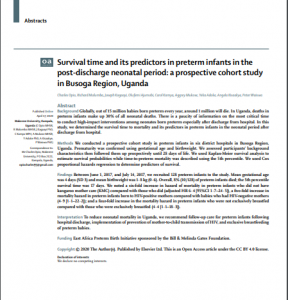
View Resource
Background
Globally, out of 15 million babies born preterm every year, around 1 million will die. In Uganda, deaths in preterm infants make up 30% of all neonatal deaths. There is a paucity of information on the most critical time to conduct high-impact interventions among neonates born preterm especially after discharge from hospital. In this study, we determined the survival time to mortality and its predictors in preterm infants in the neonatal period after discharge from hospital.
Methods
We conducted a prospective cohort study in preterm infants in six district hospitals in Busoga Region, Uganda. Prematurity was confirmed using gestational age and birthweight. We assessed participants’ background characteristics then followed them up prospectively until 28 days of life. We used Kaplan-Meier survival analysis to estimate survival probabilities while time-to-preterm mortality was described using the 5th percentile. We used Cox proportional hazards regression to determine predictors of survival.
Findings
Between June 1, 2017, and July 14, 2017, we recruited 128 preterm infants to the study. Mean gestational age was 4 days (SD 3) and mean birthweight was 1·8 kg (0·6). Overall, 8% (10/128) of preterm infants died; the 5th percentile survival time was 17 days. We noted a six-fold increase in hazard of mortality in preterm infants who did not have kangaroo mother care (KMC) compared with those who did (adjusted HR 6·4 [95%CI 1·7–24·5]), a five-fold increase in mortality hazard in preterm infants born to HIV-positive mothers compared with babies who had HIV-negative mothers (4·9 [1·1–22·2]); and a four-fold increase in the mortality hazard in preterm infants who were not exclusively breastfed compared with those who were exclusively breastfed (4·4 [1·1–18·3]).